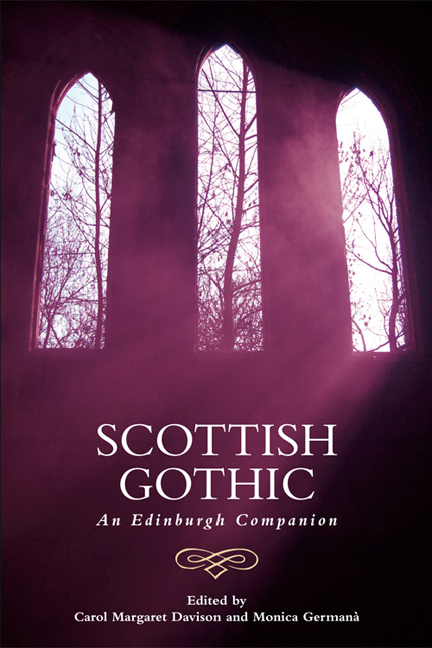Book contents
- Frontmatter
- Contents
- Acknowledgements
- 1 Borderlands of Identity and the Aesthetics of Disjuncture: An Introduction to Scottish Gothic
- 2 ‘The Celtic Century’ and the Genesis of Scottish Gothic
- 3 The Politics and Poetics of the ‘Scottish Gothic’ from Ossian to Otranto and Beyond
- 4 Robert Burns and the Scottish Bawdy Politic
- 5 Scottish Gothic Drama
- 6 Scottish Gothic Poetry
- 7 Calvinist and Covenanter Gothic
- 8 Gothic Scott
- 9 Gothic Hogg
- 10 ‘The Singular Wrought Out into the Strange and Mystical’: Blackwood's Edinburgh Magazine and the Transformation of Terror
- 11 Gothic Stevenson
- 12 J. M. Barrie's Gothic: Ghosts, Fairy Tales and Lost Children
- 13 The ‘nouveau frisson’: Muriel Spark's Gothic Fiction
- 14 Scottish Gothic and the Moving Image: A Tale of Two Traditions
- 15 New Frankensteins; or, the Body Politic
- 16 Queer Scottish Gothic
- 17 Authorship, ‘Ghost-filled’ Islands and the Haunting Feminine: Contemporary Scottish Female Gothic
- Notes on Contributors
- Index
8 - Gothic Scott
Published online by Cambridge University Press: 20 December 2017
- Frontmatter
- Contents
- Acknowledgements
- 1 Borderlands of Identity and the Aesthetics of Disjuncture: An Introduction to Scottish Gothic
- 2 ‘The Celtic Century’ and the Genesis of Scottish Gothic
- 3 The Politics and Poetics of the ‘Scottish Gothic’ from Ossian to Otranto and Beyond
- 4 Robert Burns and the Scottish Bawdy Politic
- 5 Scottish Gothic Drama
- 6 Scottish Gothic Poetry
- 7 Calvinist and Covenanter Gothic
- 8 Gothic Scott
- 9 Gothic Hogg
- 10 ‘The Singular Wrought Out into the Strange and Mystical’: Blackwood's Edinburgh Magazine and the Transformation of Terror
- 11 Gothic Stevenson
- 12 J. M. Barrie's Gothic: Ghosts, Fairy Tales and Lost Children
- 13 The ‘nouveau frisson’: Muriel Spark's Gothic Fiction
- 14 Scottish Gothic and the Moving Image: A Tale of Two Traditions
- 15 New Frankensteins; or, the Body Politic
- 16 Queer Scottish Gothic
- 17 Authorship, ‘Ghost-filled’ Islands and the Haunting Feminine: Contemporary Scottish Female Gothic
- Notes on Contributors
- Index
Summary
For record numbers of viewers in the summer of 2015, Scottishness and Gothic were provocatively juxtaposed in the exhibition Alexander McQueen: Savage Beauty at the Victoria and Albert Museum in London (first staged at New York's Metropolitan Museum of Art in 2011). McQueen's collections, Highland Rape (1995) and The Widows of Culloden (2006), while distinct from his more overtly macabre uses of Gothic, dramatise not only a personal family identity but also an interrogative, sometimes confrontational, approach to Scottish history and ‘heritage’ (with all the ironic inflections of that term): ‘I like to challenge history’, McQueen stated in 2008 (Wilcox 2015: 51). The grandeur and poignancy of the exhibition's staging of pieces from The Widows of Culloden, in particular, invite reflections on where Scottish ‘history’ most strongly emerges as a construct of narrative and design – as something which possesses creative and intellectual coherence but which explicitly opens itself up to question, to ‘challenge’. It is not only McQueen's use of the MacQueen tartan and his circling round the cultural aftermath of the definitive Jacobite defeat at Culloden in 1746 which should bring those interested today in Scottish Gothic back to Sir Walter Scott. Scott's first novel, Waverley; or, ‘Tis Sixty Years Since (1814), convincingly reanimated the uprising of 1745–6 for generations of readers, but did so in a narrative of complex and pervasive disempowerment. As Edward Waverley experiences before the Battle of Prestonpans, being caught up in a deep cultural past can generate not the reassuring connectedness traditionally expected of historical fiction, but difference and alienation:
It was at that instant, that looking around him, he saw the wild dress and appearance of his Highland associates, heard their whispers in an uncouth and unknown language, looked upon his own dress, so unlike that which he had worn from his infancy, and wished to awake from what seemed at the moment a dream, strange, horrible, and unnatural.
(Scott 1993–2012, vol. 1: 236)- Type
- Chapter
- Information
- Scottish GothicAn Edinburgh Companion, pp. 102 - 114Publisher: Edinburgh University PressPrint publication year: 2017

